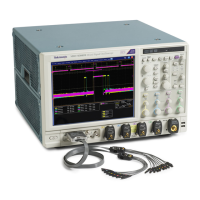Commands Listed in Alphabetical Order
Examples
CH2:PROBE:DEG
AUSS:STATE?
might return :CH2:PROBE:DEGAUSS:STATE
PASSED
, indicating that the probe attached to the Channel 2 has been degaussed.
CH<x>:PRObe:FORCEDRange
This command sets the attac hed probe to the specified range, or it queries the
range of the probe attached to the specified channel. The channel is specified by x.
The value of x can range from 1 through 4 .
Group
Vertical
Syntax
CH<x>:PRObe:FORCEDRange <NR3>
CH<x>:PRObe:FORCEDRange?
Arguments
<NR3> specifies the probe range.
Examples
If a TCP0030 current probe is attached to the Channel 1 input,
CH1:PROBE:FORCEDRANGE 5.0 sets the attached probe to its 5 Ampere range.
CH1:PROBE:FORCEDRANGE? might return :CH1:PROBE:FORC EDRANGE
2.5000
, indicating that the range of the probe attached to the Channel 1 is set to
2.5 Ampere.
CH<x>:PRObe:GAIN? (Query Only)
This query-only command returns the gain factor of the probe that is attached to
the specified channel. The channel is specified by x. The value of x can range
from 1 through 4. The “gain” of a probe is the output divided by the input transfer
ratio. For example, a common 10x probe has a gain of 0.1.
Group
Vertical
Syntax
CH<x>:PRObe:GAIN?
Related Commands
CH<x>:SCAle
Examples
CH2:PROBE:GAIN? might return :CH2:PROBE:GA IN 0.1000E+00, indicating
that the attached 10X probe delivers 0.1 V to the Channel 2 BNC for every 1.0 V
applied to the probe input.
DPO7000, DPO70000/B and DSA7000/B Series Programmer Manual 2-117

